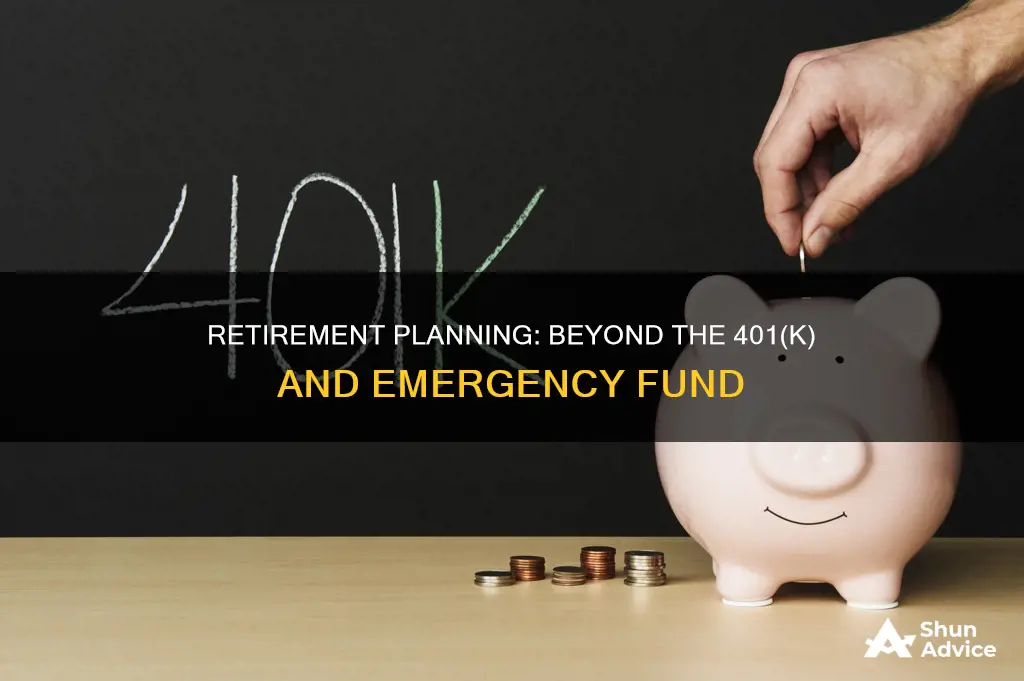
Deciding whether to contribute to your 401(k) or to build an emergency fund is a common dilemma, especially for those starting their first job or who are new to saving money. While both are important, if you have limited resources, you may have to choose one over the other.
An emergency fund is a basic savings plan where most new savers should start. It can help you avoid financial desperation and provide for immediate needs, like an unexpected expense or a period of unemployment. On the other hand, a 401(k) is intended for the distant future, and it's important to start building your retirement nest egg early.
So, which should you prioritise?
What You'll Learn

Prioritise your emergency fund if you have an unstable job
If you have an unstable job, prioritising your emergency fund over other investments is a wise move. Here's why:
First and foremost, an emergency fund provides financial security and peace of mind. In an unstable job market, having a cushion of savings can help you navigate unexpected expenses or periods of unemployment without falling into debt. This sense of financial stability is crucial for your emotional well-being and can prevent you from feeling the financial strain of unexpected events.
The amount you should aim to save in your emergency fund depends on your personal circumstances. Financial experts generally recommend having enough to cover three to six months' worth of essential living expenses, such as housing, food, and utilities. However, some advisors suggest a more conservative approach of saving up to 12 to 18 months' worth of expenses, especially if you work in an industry with higher compensation or an unstable job market.
It's important to assess the stability of your job and industry when deciding how much to save. If your job or industry is unstable, you may need a larger emergency fund to cover a potentially longer period of unemployment. On the other hand, if you work in a stable industry with a high demand for jobs, you may not need as much in your emergency fund.
While saving for retirement is also important, an emergency fund should take priority if you have limited financial resources. Retirement savings are intended for the distant future, while an emergency fund is designed to help you navigate immediate financial challenges. If you don't have enough savings to cover unexpected expenses, you may end up taking on more debt, which could impact your long-term financial outlook.
Additionally, if you have to withdraw money from your retirement savings before the age of 59 and a half, you may face a 10% penalty on the amount withdrawn. This further emphasises the importance of having a robust emergency fund to cover unexpected costs.
In summary, if you have an unstable job, prioritising your emergency fund is crucial. It provides financial security, peace of mind, and the ability to handle unexpected expenses without falling into debt. Assess your personal circumstances and job stability to determine how much you should save, with the general guideline being three to six months' worth of essential expenses. While retirement savings are important, an emergency fund should take precedence to ensure you're prepared for immediate financial challenges.
The Best Time to Invest in Funds: Morning or Evening?
You may want to see also

Consider your risk tolerance and the likelihood of emergencies
When deciding between contributing to your 401(k) or building an emergency fund, it's important to consider your risk tolerance and the likelihood of facing financial emergencies. Here are some factors to keep in mind:
Understanding Risk Tolerance
It's crucial to assess your tolerance for financial risk. While investing in a 401(k) plan offers potential long-term gains, it also carries market risks that could impact your retirement savings. On the other hand, building an emergency fund in a savings account is generally considered a more conservative approach, offering stability and immediate access to funds during unexpected financial crises.
Evaluating Financial Stability
Evaluate your current financial situation and job stability. If you work in an unstable industry or face frequent job changes, prioritising an emergency fund can provide a safety net to cover living expenses during periods of unemployment. This fund ensures you have liquid cash to manage unforeseen expenses without resorting to high-interest debt.
Balancing Short-Term and Long-Term Goals
Striking a balance between short-term and long-term financial goals is essential. While retirement planning is crucial, an emergency fund ensures you can handle immediate financial challenges without derailing your long-term plans. Consider setting aside enough funds to cover at least three to six months' worth of essential living expenses, giving you peace of mind and financial resilience.
Maximising Employer Matching Contributions
If your employer offers matching contributions to your 401(k) plan, it's generally advisable to contribute enough to take full advantage of this benefit. Employer matching is essentially "free money" that boosts your retirement savings. However, consider the vesting requirements, as you may need to remain with the company for a certain number of years to fully benefit from the matching contributions.
Managing Debt Responsibly
Assess your debt obligations, such as credit card debt or student loans. Focus on reducing high-interest debt to improve your overall financial health. While an emergency fund is important, ensuring that your debt doesn't accumulate excessively is also crucial. Consult a financial advisor to determine the best strategy for managing your debt and building savings simultaneously.
In conclusion, building an emergency fund and contributing to a 401(k) plan are both essential components of a comprehensive financial strategy. By considering your risk tolerance and the likelihood of financial emergencies, you can make informed decisions about prioritising your savings and investments to achieve your short-term and long-term financial goals.
Index Funds vs Roth IRA: Where Should You Invest?
You may want to see also

Weigh up the benefits of your employer matching your 401(k) contributions
Weighing up the benefits of your employer matching your 401(k) contributions is an important consideration when deciding where to allocate your money. Here are some key points to consider:
The advantage of employer matching
Matching contributions from your employer are essentially free money. It is an incentive offered by your employer to encourage you to save for retirement. Typically, employers will match a certain percentage of your contributions, up to a specified limit. For example, a common arrangement is a 50% match on an employee contribution of 6%, resulting in a total employer contribution of 3%. This means that if you contribute $100, your employer will contribute $50, giving you a total of $150 in your 401(k) account. Over time, these contributions can add up to a significant amount, boosting your retirement savings.
Vesting requirements
However, it is important to consider vesting requirements. Vesting refers to the length of time you need to remain employed with the company to fully own the matching contributions. If you leave the company before the vesting period is complete, you may forfeit some or all of the matching funds. For example, if the vesting period is five years, and you leave the company after two years, you may lose a portion of the matched funds. It is crucial to review the vesting requirements and understand the potential impact on your long-term savings goals.
Impact on tax obligations
Contributing to a 401(k) can also provide tax advantages. When you contribute to a 401(k), you are often able to do so with pre-tax dollars, reducing your taxable income. This can result in lower tax obligations in the year you make the contributions. Additionally, the money in your 401(k) account grows tax-free until you withdraw it during retirement. This allows you to benefit from compound interest without the drag of annual taxes. However, when you do make withdrawals in retirement, you will pay taxes on the distributions at your income tax rate at that time.
Loan provision
Some 401(k) plans also offer a loan provision, which can serve as a backdoor emergency fund. While taking out a loan from your 401(k) is not ideal, it may be a better option than high-interest credit card debt or other costly loans. However, it is important to carefully consider the risks and potential impact on your retirement savings before utilizing this option.
Prioritizing between 401(k) and emergency fund
The decision to prioritize your 401(k) or emergency fund depends on various factors, including your financial situation, employment stability, and debt load. If your employer matches your 401(k) contributions, it becomes a more compelling option as you are leaving money on the table if you don't contribute. However, it is still essential to balance this with building an emergency fund to cover unexpected expenses and provide financial stability.
Key Factors for Investors to Consider in Mutual Funds
You may want to see also

Assess your debt load and interest rates
Before investing in anything, it's important to assess your debt load and the interest rates associated with it. This is because debt can be a significant burden on your finances, and the interest rates can make it even more challenging to get out of debt.
Start by making a list of all your debts, including credit card debt, student loans, mortgage, car loans, and any other outstanding payments you need to make. Calculate the total amount of debt you have and the average interest rate you're paying. This will give you a clear picture of your debt load and the cost of borrowing.
If you have high-interest debt, such as credit card debt, it's crucial to prioritize paying it off as soon as possible. The longer you take to repay high-interest debt, the more you will end up paying in interest. Create a plan to aggressively pay down this debt by allocating a significant portion of your budget to these payments.
On the other hand, if you have low-interest debt, such as a mortgage or certain student loans, you may have more flexibility in your investment choices. However, keep in mind that while these types of debt may have lower interest rates, the total amount of debt can still be substantial due to the large principal amounts typically involved.
Once you have a handle on your debt load and interest rates, you can make more informed decisions about your investments. Consider the potential returns on your investments and weigh them against the cost of your debt. Remember that paying off debt is a form of investment in itself, as it improves your overall financial health and reduces the burden of interest payments.
- List your debts: Identify all your debts, including credit card debt, loans, and outstanding payments.
- Calculate total debt and interest: Determine the total amount of debt and the average interest rate to understand the cost of borrowing.
- Prioritize high-interest debt: Focus on repaying high-interest debt, such as credit card debt, as soon as possible to minimize the overall cost.
- Weigh investment returns: Compare the potential returns on investments with the cost of your debt to make informed decisions.
- Paying off debt is an investment: Remember that reducing your debt improves your financial health and frees up money for future investments.
Best S&P Index Funds: Top Picks for Your Portfolio
You may want to see also

Calculate how much you need to save for emergencies
It's important to have an emergency fund to cover any unexpected costs, such as medical bills or car repairs. This fund should be easily accessible, so you can quickly get to your money in an emergency.
How much you need to save depends on your personal circumstances. If you are single, it is recommended to have between three months and one year's worth of essential expenses saved. This includes money for your home, food, and utilities. If you are in a couple where both people are earning, you may only need savings for three to six months.
If you are in a less stable job or industry, you should aim for the higher end of the savings range. This will ensure you can cover your living expenses for a reasonable amount of time while you find a new job.
It's also worth considering your debt load. If you have a lot of debt, an emergency fund is critical to prevent you from going further into debt when unexpected expenses arise.
In addition to an emergency fund, you should also be contributing to your retirement savings. If you are able to, it is recommended to contribute enough to your 401(k) to get the full company match. This will help your money go further.
Savings Strategy: Mutual Funds Investment Allocation
You may want to see also
Frequently asked questions
An emergency fund is a basic savings plan that can help you avoid financial desperation and is intended to cover immediate needs. It can help you cover unexpected expenses such as medical bills or car repairs, and it can also provide a cushion if you lose your job or encounter financial instability.
This depends on your personal situation and career sector. Financial experts recommend having anywhere from three months to one year's worth of essential expenses covered. Some suggest that this should be in the form of liquid cash, while others recommend putting your money in a short-term certificate of deposit or a blue-chip stock or bond fund.
A 401(k) is a long-term retirement plan that can supplement your income in your senior years, especially if you anticipate having higher expenses or wanting extra cash to enjoy your free time. Many employers will match your contributions up to a certain percentage, and contributing to a 401(k) can also reduce your income tax burden.







